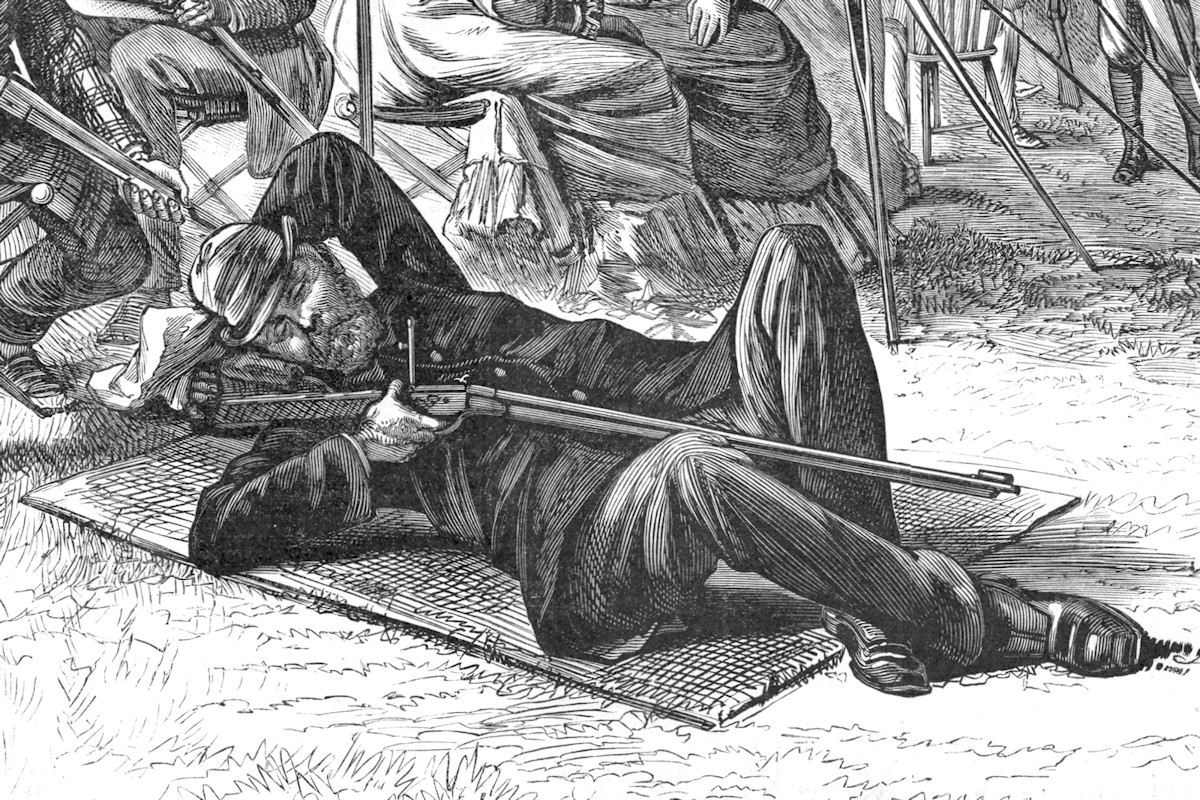You are here: Home > Marksmanship > The Art of Shooting with the Rifle
Written by: Frank W A Sutton
Enfield Optics > Explanation & Lesson > Spectacles, Diffraction and Aiming Off
Problems with open sights for the shooter past the first flush of youth
(First published in two parts by the Muzzle Loaders Association of Great Britain (MLAGB – www.mlagb.com) in Black Powder, Volume 29, No.1 (March) & 2 (June), 1982 – reprinted in 2001 & 2022. Published by Research Press with permission. Copyright 2022 MLAGB)
At one time my Enfield scores took a decided dip and I was at a loss to identify the cause; at least, lying in the patchily grassed mud with rain slanting in at 12 o’clock I was not in the best mood for critical trouble shooting. I decided to theorise a little and devise some diagnostic experiments.
- A score of 90 or over with our target at 100 metres using an Enfield is a fairly elusive thing. Replacing this rifle with a quality .22 rifle with fine aperture sights front and back and match ammunition, would have the effect of producing scores of 99 and 100 with regularity, particularly with our 10/13 system of ‘sighters’. The question is, how much is this 10 point difference due to the differences in the two types of sighting facilities?
- This question was very germane to my problems because, with advancing age, my eyesight was getting demonstrably poorer. This fault can be corrected to a great degree with the paraphernalia of modern aperture sights, whereas with crude open sights the available legal corrective methods seem to leave much more to be desired. Because my aperture-sight, breech-loading scores had not taken the same dip, it was tempting to think that my worsening eyesight was the cause of the Enfield problem.
- This sight fault is the common geriatric one (presbyopia) whereby the nearest distance of distinct vision marches progressively away from one as time goes by. Thus, the aiming mark is clear but the foresight is a blur and the rear sight is a lump of lightly compressed cobwebs; a disastrous sight-picture.
The available remedy is a convex spectacle lens which is only just strong enough to clarify the foresight. This produces the least fuzziness to the aiming mark but fuzzier it will certainly be. The rear sight will still be vague but slightly improved. In my case, was this imperfect compromise becoming so bad that sighting errors were causing the problems or had my bedding gone sour or what?
Experimental
The idea was to remove the non-sight-related elements of the problem in order to examine the sighting facility itself, and the method used was to shoot with a reliable .22 rifle fitted with open sights. The BRNO model 4 is excellent for this purpose. It weighs 10 pounds and the trigger pressure can be fiddled up to equate to that of the Enfield. I filed a flat foresight element to a point and I filed a V notch in the open rear-sight so that the sight-picture was exactly Enfieldian. The rear-sight can be mounted in its locating grooves to be the same distance from the eye as in the case of the 3-bander. Targets were then constructed by scaling down our standard target from 100 metres to 25 yards.
| Dimensions: | Aiming mark | 45.4 mm |
| 8 ring | 33.9 mm | |
| 9 ring | 22.5 mm | |
| 10 ring | 11.0mm |
This rifle was then shot at this target in an indoor 25 yd range; the 10/13, ‘50% over’ criteria were used for scoring. After ‘zeroing’, 8 cards were shot over a 3 week period and the normal corrective lens was used throughout. The scores varied between 94 and 98 and averaged 95.9. The sight-picture was as bad as ever. The rifle was then fitted with aperture sights and as expected it turned in scores of 99 and 100.
Conclusions and Innuendos
- Certainly I found the crude open sights a disadvantage compared with apertures but it was good, at least, to see this effect roughly quantified ie by about 4 points per 100. This might be reduced with practice but in my case probably not by very much.
- However, 96 would still be a handsome score with an Enfield even on a still well-lit day (c.f. indoor range) so I could discount my sighting inefficiency as a necessary cause of dropping scores from 86 to 76.
Armed with this new and well-founded confidence in a frightful sight-picture, I took my Enfield on the 100 yards range and shot an 86 and 87!
